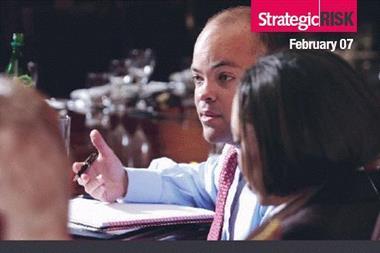Mathias Estrade, Cyril Végni and Audrey Gandon underline the importance of managing the risks at the heart of the purchasing function
Is there any organisation today which can claim its activities are free from any kind of regulation? The international standards IAS/IFRS, Sarbanes-Oxley in the US, Turnbull in the UK, the ‘Loi de Securité Financiere’ in France. Basel II, Solvency II, ISO 9001 and 14001 are some of the regulations which provide the rules for entire sectors of activity and which establish best practice in areas as diverse as heavy industry, energy, bank-assurance, aerospace, information technology and communications.
All these regulations have one thing in common. Not one of them has the objective of enabling an enterprise to expand commercially or grow its revenues. On the contrary, these grand regulatory projects demand significant human and financial resources to set up and apply them, and are the cause of large outpourings of cash. Where margins are thin and competition fierce, enterprises must therefore rapidly seek ways of bringing costs and receipts into balance.
Purchasing: the core of performance
At this point, two solutions clearly emerge. The first is to manage client relationships more precisely; the second is to increase margins by increasing efficiency and controlling costs. Recently, most organisations have been concentrating on these two actions, with the result that we have seen a marked growth in the power of the purchasing function over the last decade.
This has been felt in all sectors at the level of operational purchasing, and has tended to spread into other purchasing areas too, as a response to the problem of reducing operating costs. The professionalisation of the purchasing function has thus been fundamental, enabling it to be separated out from the procurement function – of which it is no longer a part. In order to rationalise purchasing procedures and gain operating efficiency, purchasing managers must continually drive through their judgments in the face of often contradictory pressures, such as the rigidity of the production process, the need for innovation and flexibility, and the intensity of the competition.
However, on top of the simple problem of acquiring the best product for the best price, the purchasing function these days is also becoming involved in more complicated strategic issues within the organisation. When decisions have to be taken about externalising functions, developing new markets, producing in low-cost countries, managing the issues surrounding outsourcing, or involvement in large-scale projects, the purchasing function ought to be providing a concrete input into the strategic thrust of the organisation.
The management of such sensitive areas, and the complexity of the tripartite relationship between internal client, buyer and supplier are all too often sources of risks. At the very least, it is necessary to identify and evaluate them. We do not attempt here to lay down any universal principles for the management of purchasing risks. They will be different in every sector and every organisation. But we believe it is important to bring forward some different areas for consideration, while maintaining the thought that the management of purchasing risks is a real lever for growth.
Establishing a policy
The strategic objective behind establishing a policy for managing purchasing risks is to assure an acceptable level of risk by establishing procedures which take account of all the legal, technical, economic, human and organisational aspects.
In contrast to received thinking, establishing a policy for managing purchasing risks is entirely compatible with the commercial, marketing and even legal demands of an organisation. In fact, it supports them by integrating them as aspects connected to the purchasing function.
Among other things, a policy for managing purchasing risks tends to strengthen the image of an organisation, together with its credibility in the eyes of its partners. It should also ensure the continuation of the process in the face of economic or technological change. It is, however, all too often perceived by the boardroom as a source of needless costs – despite the fact that it could prevent losses on a scale that would bear no relationship to the investment involved in setting it up.
The first step in developing a policy for managing purchasing risks is to undertake an appraisal of the cumulative vulnerabilities of the organisation in that area. Such an appraisal of risks more often than not leads to a confirmation of the difficulties of managing and measuring the risks incurred, and of assessing their impact over the short, medium or long term.
Once the appraisal has been undertaken and the problems posed by purchasing risks are understood, the second step consists of identifying and evaluating the potential risks against the objectives and obligations which the organisation has set itself. A map of purchasing risks can be drawn up on the base of a transverse survey of the purchasing process.
“The purchasing function these days is also becoming involved in more complicated, strategic issues within the organisation
The third and last step consists of investigating and then optimising the means of managing the identified risks. In other words, the methods to be undertaken for reducing a risk are surveyed and classified in the light of how serious and enduring its impact on the organisation is considered to be.
It would be a delusion to think that drawing up a map of purchasing risks is the end of the matter.
It is fundamental to integrate this work into an ongoing programme of improvements, which the organisation must use to reinforce a risk culture and the spread of good practice at its heart by:
- drawing the relevant lesson from the analysis
- formally establishing the necessary controls and adjusting them on a day-to-day basis
- training the people involved, and communicating about purchasing risk in a targeted manner.
Overview of principal risks
The risk that one most often runs across in the purchasing function is tied to supply risk – that is to say the relationship that the enterprise has with each supplier. The trend towards large programmes of outsourcing and subcontracting and the dependence on independent 'freelancers’ has become extensive and, in exposing enterprises to the potential failure of a strategic supplier, has pushed purchasers to become top contributers to business continuity plans.
To think of supplier risk as a simple finance risk is a mistake. Although some still think otherwise, cost advantage is not the only thing to take into account during the selection of a subcontractor. It is obvious – given the need for business continuity – that it will be a rare purchaser who entrusts its business to the hands of a supplier of fragile financial health or who has insufficient production capacity, but purchasers need to pay attention to other factors as well. These may themselves reveal risks. At the heart of supplier risk are the easily-measured risks: the risk of financial failure, logistic or procurement risks, quality risks and technical or technological risks. However, purchasing managers need to go further and address the less easily assessed risks: ethical and social risks, environmental risk and the risk to reputation.
With these different types of risk in mind, the purchaser should equally concentrate on repairing the internal points of dysfunction which could be the origin of major risks. In addition to the traditional risks inherent in all the key functions of the enterprise, from a purely operational point of view, the designation, establishment, control and improvement of the purchasing process can all be the setting for unsuspected pitfalls. We can consider, among others, lack of transparency, country risks for international purchasing, change risks, inadequacy of tools and contract risk. It is worth noting, in the field of contracts, that even where most contracts are drawn up by the legal function, cases of imprecision or invalidity are not unknown.
Going beyond operational risks, purchasing managers are faced with the risks linked to the management and structure of the enterprise. To a great extent these are a part of the flow of information circulating between the three protagonists of purchasing: the internal client, the purchaser and the supplier. Another actor can appear, to further complicate this relationship, when the internal client, who originates the purchasing order, is not in reality the end user of the object or service purchased.
Responsible purchase?
Corporate social responsibility and ethical purchasing are terms which can cover environmental aspects (reduction of greenhouse gases, energy conservation, sustainable natural resources) just as much as the social ones (human rights, security of employment). Reducing this global parameter shift to a discussion of the risk to reputation would be a bad mistake, even if it is true that ‘put the ethics on the label’ is something of a buzzword.
“Buying well is to buy responsibility
It is possible to define corporate social responsibility as the fashion in which organisations combine social and environmental preoccupations with their economic objectives – and this can be done even in the act of buying something. In short, buying well – the best quality for the best price, taking into account simple ethical rules – is to buy responsibly.
The point of ethical purchasing at the heart of business is that it responds equally to a complex social need for coherence, the social aspirations of people and the economic activity of the business. Once in place, it allows the whole business ladder, from suppliers to the entire sector, to promote basic human rights, such as the prevention of slave or illegal labour, prevention of child labour, respect for the freedom to organise and negotiate collectively, refusal to discriminate on grounds of sex, race or religion and adherence to health and safety rules at work. To this approach to human rights can be greater respect for the environment.
When it comes to managing social responsibility risk in the organisation, the question arises of how to analyse it. And once the choice has ended up between studying it vertically (ie at the level of key activities) or horizontally, across all the operational units, the further question arises of who identifies, evaluates and takes the responsibility for managing this risk? Nothing is less simple than deciding who, among the internal client, purchaser, risk manager or the person responsible for sustainable development should shoulder the burden of a risk which is most frequently indirect – because generated in most cases by a supplier or an unscrupulous subcontractor. To say that all these people should work together is obvious. Yet it is also true that saying that mastering the corporate social responsibility risk is everyone’s business, demonstrates the complexity of the task.
There is no doubt that the realisation of a responsibility which is as much individual as collective has already reached the point where numerous organisations are deploying whole ethical policies, in order to influence the environmental footprint they leave behind.If it is true that adopting a socially responsible approach in the organisation reverts to a long-term perspective on growth, it is equally the case that taking this stance is a factor in the formal and informal validation of the enterprise by its stakeholders (customers, suppliers, workers, regulators, etc) as they take account of the part played by social and environmental initiatives in the strategic development of the organisation. And there is nothing anodyne about the approach, for it deeply influences the values, culture and strategic decision-making of the organisation. Furthermore, it allows outsiders to rapidly sort civilised, responsible enterprises from the bandits who take little account of either human rights or of the environment.
Change and purchasing risk
In risk management, change plays a central role in mastering hazard. Beyond the specific boundaries of purchasing risk, the whole enterprise is organised to give itself a coherent frame of reference, bringing a sense of safety to the actions undertaken by its members. Thus the optimisation of the purchasing process may be seen as a response provoked by, or suffered by, an organisation in the face of internal or external factors pushing for change and reorganisation. Turning desire into concrete actions for driving change requires working four levers: management, structure, system and culture. These levers closely overlap and are all central to change. However, depending on the degree of change required, the levers can be partially or totally worked on, or combined
In the context of driving the change process towards the end of mastering purchasing risks, the management lever has to be the priority for action, since it is the source of the initialisation of the process, and strongly influences the success of its implementation. This suggests immediate attention to how the ‘components’ of this lever can share in the taking of responsibility and involvement of management, and attention to their strengths and weaknesses. For example, the effort of promoting awareness among purchasers and internal clients is one of the priority actions in the course of mastering purchasing risks.
The structure defines the way in which the resources of an enterprise are organised. It defines the context in which each resource is located, as well as the relationships existing between each level of the structure, and their role at the heart of the structure. It is at this structural level that the relationship between purchasing management and general management is formalised, and equally those between the buyers and the internal customers.
The system defines the manner in which information flows formally or informally within and outside the structure. The responsiveness of an enterprise to its environment is extremely dependent on the functioning of the system.
The system has direct influence on decision-making, and on the flexibility and the capacity to react of different players. One might mention as an example the ‘e-work’ undertaken by certain managements to optimise the purchasing process – e-procurement, e-sourcing.
The culture as a whole refers as much to the organisation's attachment to social values (sense of belonging to a profession, of adhering to corporate values) as to attachment to professional values (respect for the customer, transparency) Without doubt, the most complicated parameter to come to terms with, culture changes only slowly and is not transparent. It evolves more through day-to-day actions than through the edicts of management.
As a result, one method of using culture to ease and accelerate change is to make it one of the shared values of the enterprise.
The ten chief strategic missions of the purchasing function:
1. Optimisation and reduction of costs
2. Assuring the durability of supplier relations,
to assure continuity of supply and service
3. Setting up solid and lasting contractual relations
4. Preserving brand image throughout the
supplier network
5. Developing new geographical markets at
minimum cost
6. Rationalisation of the supplier network
7. Innovation
8. Improving quality
9. Seeking improved logistic flexibility
10. Aid in decision-making over whether to make
or buy
Six measures to rapidly put in place to counter corporate social responsibility risk:
1. Take account of CSR issues in choosing suppliers
2. Back up qualification and reference processes by undertaking social or environmental audits
3. Lay down a code of conduct for purchasing
4. Integrate measures for reduction in energy use, water use, raw material consumption and
packaging into your planning
5. Train purchasing teams in risk management ideas
6. Write restrictive clauses concerning human rights and the environment into purchasing agreements
Postscript
Mathias Estrade and Cyril Végni are partners at French risk management consultancy Oxéa. Audrey Gandon is a specialist in purchasing risks
Tel +33 (0)1 46 10 95 80 • www.oxeaconseil.com



















